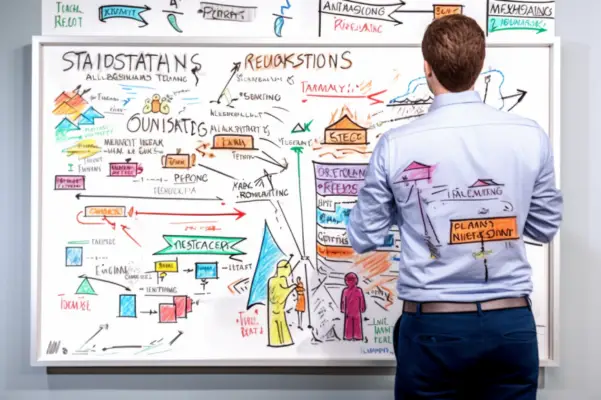Risk response planning involves developing strategic options and determining actions to enhance opportunities and reduce threats to project objectives. The process focuses on improving the likelihood and impact of positive events while reducing the likelihood and impact of negative events.
Risk response planning can be broken down into the following steps:
Identify Risks: Before you can plan for risks, you need to know what potential threats exist. This could be anything from potential delays in delivery to the risk of a natural disaster impacting operations.
Analyze Risks: Once risks are identified, they need to be analyzed. This involves determining the potential impact of the risk, as well as its likelihood of occurrence.
Plan Risk Responses: After analyzing the risks, you can plan appropriate responses. This might include mitigation strategies (to reduce the potential impact or likelihood of a risk), contingency plans (for when a risk event does occur), or acceptance (where the risk is deemed to be unavoidable or the cost of mitigation is higher than the impact of the risk).
Monitor and Control Risks: Once the risks have been identified, analyzed, and planned for, they must be continuously monitored and controlled. This means regularly reassessing risks, executing risk response plans when needed, and evaluating the effectiveness of chosen strategies.
Risk response strategies for threats typically fall into one of four categories:
Avoidance: This involves changing the project plan to eliminate the risk or to protect the project objectives from its impact.
Mitigation: This is a risk reduction method to either reduce the likelihood of a risk occurring or reduce the impact if it does.
Transfer: This means shifting the negative impact of a threat, along with the ownership of the response, to a third party. This could involve buying insurance or outsourcing the risky activity.
Acceptance: Some risks may be accepted if the cost of other risk strategies outweighs the cost of the risk itself. This can be done passively by just accepting it, or actively by setting up contingency reserves (time, money, resources) to handle the risk if it happens.
Risk response planning aims not to eliminate all risks. Rather, it’s about understanding what risks exist and how they can be managed to allow the project to move forward as effectively and efficiently as possible.
In today’s competitive business world, unexpected incidents such as natural disasters, cyberattacks, and economic downturns can severely impact a company’s bottom line. Companies must develop strategies that help them identify potential risks and create contingency plans to respond effectively.
To understand risk response planning, it’s important first to comprehend what risk management is. Risk management involves identifying potential risks and developing strategies to manage or eliminate them. It involves assessing various business risks and implementing policies and procedures to mitigate their impact.
Effective risk management requires a thorough understanding of different risks and how they may affect a business, including financial, operational, strategic, compliance-related, reputational, environmental, or technological risks.
This article explores what risk response planning entails by delving into the types of risks businesses face and offering tips on developing effective policies and procedures that can help manage these risks proactively.
Understanding Risks
An integral aspect of developing a risk management plan is understanding the types of risks that can affect a business. Effective risk response planning requires a comprehensive understanding of potential threats and their likelihood.
Risks can be categorized into different types, such as financial risks, operational risks, strategic risks, and compliance risks. To assess risks, businesses must identify situations that could negatively impact their operations or performance. This assessment should consider internal and external factors that could cause harm to the organization.
Once identified, businesses should prioritize risk planning by first focusing on the most significant threats. This approach enables companies to develop contingency plans for high-priority events before moving on to less critical ones.
Developing contingency plans involves creating strategies for mitigating the effects of risk events if they occur. These strategies provide businesses with actionable steps to minimize damage during unexpected circumstances.
Contingency plans may include disaster recovery procedures, backup systems, crisis communication protocols, and emergency response teams.
Businesses can better prepare for unforeseen events that could otherwise jeopardize their operations and success.
Types of Risks
Various factors may pose potential threats to a business, including financial risks, market risks, and operational risks. Firstly, financial risks refer to the possibility of loss due to changes in interest rates, currency exchange rates, or credit defaults.
Market risks arise from changes in market conditions, such as consumer preferences or economic trends. Lastly, operational risks result from inadequate processes and systems that may lead to errors or fraud.
Businesses must identify and assess these risks using risk response planning to manage them effectively. This involves developing contingency plans for each identified risk to minimize the impact on the business if they occur.
A robust risk management system should outline measures for prevention and mitigation strategies if a risk eventuates. Businesses can use three primary methods when responding to identified risks: avoidance, transfer, and reduction.
Avoidance involves eliminating or circumventing the risk altogether by not engaging in activities that pose a significant threat. Transfer entails shifting the responsibility of managing a particular risk to another party through insurance policies or contracts.
Reduction aims at minimizing the likelihood and impact of identified risks through preventative measures such as additional security protocols or backup systems.
Importance of Risk Management
Effective risk management is crucial for businesses to maintain continuity and prevent potential threats from negatively impacting their operations. One important aspect of risk management is risk response planning, which involves developing strategies to mitigate and respond to identified risks.
This process includes identifying the likelihood and potential consequences of various risks and determining the most effective ways to minimize their impact on cash flow, brand reputation, and other critical aspects of a business.
The importance of risk management cannot be overstated. By proactively managing risks, businesses can prepare for unexpected events and reduce the likelihood of major disruptions that could harm their operations.
In addition to protecting against financial losses, effective risk management can help businesses maintain positive relationships with stakeholders such as customers, employees, suppliers, and investors by demonstrating a commitment to responsible business practices.
To facilitate this process, many organizations use crisis planning templates or similar tools that guide the development of an effective risk management plan.
Investing in risk management is a smart move for any business looking to protect itself from potential threats.
Whether you’re just starting out or have been in business for years, prioritizing risk management is one of the best things you can do for your organization’s long-term success.
Developing a Risk Management Plan
A well-constructed risk management plan can help organizations minimize the impact of unexpected events, such as natural disasters, technological failures or economic downturns.
To develop an effective risk management plan, businesses must assess risks and identify potential operational threats. The following list guides on developing a successful risk management plan:
- Identify potential risks: Businesses should conduct a thorough assessment of all possible risks that could impact their operations, including financial, legal, regulatory, reputational, and operational risks.
- Develop contingency plans: Once identified, businesses should create contingency plans for each type of risk identified in the assessment phase. This step involves outlining specific actions to take if any identified risks materialize.
- Communicate the plan: Finally, businesses must communicate their risk management plan clearly with all stakeholders involved in its implementation. Effective communication ensures everyone understands what needs to be done and helps build consensus around taking proactive steps to manage risks.
Developing a well-designed risk management plan is essential for businesses to protect themselves from unexpected events that could harm their operations or reputation.
Assessing risks thoroughly and implementing contingency plans while communicating them effectively with stakeholders involved in their implementation, organizations are better positioned to navigate challenges when they arise and continue working towards achieving their desired outcomes.
Tips for Policies and Procedures
To ensure the successful implementation of policies and procedures within a business, it is important to consider the tips provided by experts in the field. Developing and maintaining effective policies and procedures is essential for managing risks in a business.
One of the key components of risk management is risk response planning, which involves developing contingency plans to address potential risks.
The first step in creating effective policies and procedures is assessing business risks. This includes identifying potential hazards or threats impacting the organization’s operations, employees, customers, or stakeholders.
Once these risks have been identified, it is important to develop strategies for mitigating them through well-designed policies and procedures. This may involve implementing preventative measures such as training programs or safety protocols.
Effective communication of risk response plans is also critical for successfully implementing them. This involves clear communication with all relevant stakeholders on the steps to take if specific risks occur.
In addition, regular updates and reviews should also be conducted to ensure that policies and procedures remain up-to-date with changing circumstances or new risks.
| Tips for Policies and Procedures | Description | Example |
|---|---|---|
| Conduct a Risk Assessment | Plan for how you will respond if specific risks occur | Communicate policy/procedure changes with relevant stakeholders |
| Develop Contingency Plans | Assessing workplace health & safety Risks | Creating an emergency evacuation plan |
| Regularly Review & Update Policies/Procedures | Ensure effectiveness by reviewing regularly & updating when necessary | Updating cyber security protocols after a data breach |
| Communicate Plan Effectively | Clearly communicate policy/procedure changes with relevant stakeholders | Holding employee training sessions on new safety protocols |
| Monitor Compliance | Regularly check that employees are following established protocols | Conducting audits and reviews of security measures to ensure compliance |
Frequently Asked Questions
What are some common mistakes businesses make when developing a risk response plan?
Common mistakes made by businesses when developing a risk response plan include not properly identifying and assessing risks, overlooking potential consequences, relying too heavily on insurance, failing to review and update the plan regularly, and not involving key stakeholders in the planning process.
How can a business measure the success of its risk management plan?
The success of a business’s risk management plan can be measured by evaluating the effectiveness of implemented policies, procedures, and processes in reducing risks and minimizing their impact on the business. Regular monitoring and reviewing of the plan are also essential.
What role do employees play in implementing a risk management plan?
Employees play a crucial role in implementing a risk management plan by following policies and procedures, identifying potential risks, reporting incidents, and participating in training programs to increase awareness and understanding of risk management strategies.
Can risk management be outsourced to a third-party provider?
Yes, risk management can be outsourced to a third-party provider. However, it is important for the business to thoroughly vet and select a reputable provider who can effectively manage and mitigate risks specific to the business’s industry and operations.
How often should a business review and update its risk management plan?
A business should regularly review and update its risk management plan to ensure it remains effective in managing current and emerging risks. The frequency of reviews may vary depending on the nature and complexity of the business operations.

Conclusion
Understanding the various types of risks an organization may face allows for developing a comprehensive plan to mitigate their impact.
Businesses can protect themselves from unexpected events by identifying potential risks and developing policies and procedures to address them.
Effective risk management requires ongoing assessment and refinement of policies and procedures and regular employee training.
Businesses need to recognize that risk response planning is not a one-time event but a continuous process that must be integrated into their operations. Organizations can better manage risks, protect their bottom line, and ensure the longevity of their business in today’s uncertain environment.

Chris Ekai is a Risk Management expert with over 10 years of experience in the field. He has a Master’s(MSc) degree in Risk Management from University of Portsmouth and is a CPA and Finance professional. He currently works as a Content Manager at Risk Publishing, writing about Enterprise Risk Management, Business Continuity Management and Project Management.



